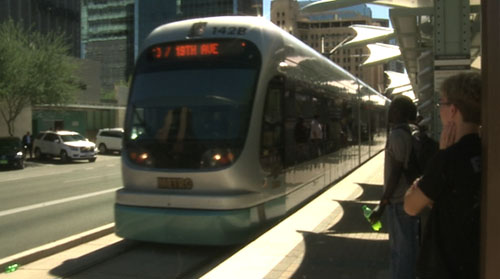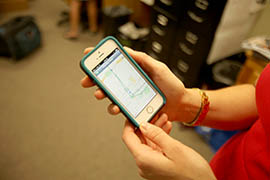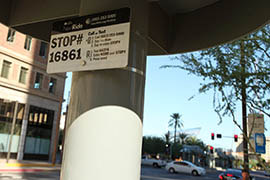Cronkite News has moved to a new home at cronkitenews.azpbs.org. Use this site to search archives from 2011 to May 2015. You can search the new site for current stories.
Group: Technology helps people dramatically cut down on driving
PHOENIX – Smartphone apps saying when the next bus is coming and ride- and bike-sharing services are among innovations enabling Arizonans to drastically cut down on driving, a public interest advocacy group reported Tuesday.
“We’re seeing an overall trend of people moving away from driving,” said Serena Unrein, public interest advocate for the Arizona PIRG Education Fund.
Relating the results of a study by U.S. PIRG, Unrein said technology is helping drive that trend, encouraging walking, biking and using public transportation.
“Young people in particular are looking for other modes of transportation,” she said. “In the past, a car used to represent freedom, and now the ability to work and email and text your friends and play games really represents freedom – and you can’t, or you really shouldn’t, do those things while you’re driving.”
Unrein said that government officials should look to that trend when planning Arizona’s transportation system of the future.
“We should be investing in bike lanes, expanded public transportation and better pedestrian infrastructure,” she said.
Arizona State University researcher Mikhail Chester said that the study’s findings are borne out in the lower rates at which 16- to 18-year-olds are getting driver’s licenses, something he says is happening for a variety of reasons.
“When the millennials have grown up, there’s this theory that they have viewed independence differently than people who are older than them,” Chester said. “If you look at 38-year-olds or older, independence was probably associated with the ability to drive a vehicle to be able to have social interactions.”
Chester said that while new technology may allow young people to be social without requiring them to be physically mobile, it’s not clear that those changes are responsible for broader shifts in the total number of miles people drive.
“As we change our travel behavior and free up the availability of the roadway, the system will adapt,” he said. “If we’re not doing little trips to local stores because we’re buying things on Amazon, that may free up time and money for other trips.”
AAA Arizona spokeswoman Stephanie Dembowski said her organization has seen the number of miles driven and demand for gasoline decline, trends that she said continue even as the economy recovers.
“The demand was expected to trend upward, but we’ve seen it trending along with vehicle miles traveled,” she said. “People have been driving less overall.”
Dembowski said AAA Arizona has also observed that teen drivers are waiting longer to get licenses and are driving less than other groups.
“Teens don’t really have the need as much to talk to their friends in person. Now they can text messages,” she said. “There’s so many other ways for teens to connect that they don’t need to get behind the wheel and go drive to visit their friends.”










